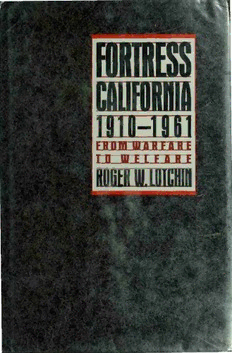
Fortress California, 1910-1961: FROM WARFARE TO WELFARE PDF
Preview Fortress California, 1910-1961: FROM WARFARE TO WELFARE
EBdm WABEABE tu WELFARE If IIH; Ill. I 111 IH Ill i I FORTRESS CALIFORNIA 1910-1961 FORTRESS CALIFORNIA 1910-1961 From Warfare to Welfare ROGER W. LOTCHIN New York Oxford OXFORD UNIVERSITY PRESS 1992 Oxford University Press Oxford New York Toronto Delhi Bombay Calcutta Madras Karachi Petaling Jaya Singapore Hong Kong Tokyo Nairobi Dar es Salaam Cape Town Melbourne Auckland and associated companies in Berlin Ibadan Copyright© 1992 by Oxford University Press, Inc. Published by Oxford University Press, Inc., 200 Madison Avenue, New York, New York 10016 Oxford isa registered trademark of Oxford University Press All rights reserved. No part of this publication may be reproduced, stored in a retrieval system, or transmitted, in any form or by any means, electronic, mechanical, photocopying, recording, or otherwise, without the prior permission of Oxford University Press. Library of Congress Cataloging-in-Publication Data Lotchin, Roger W. Fortress California, 1910-1961 : from warfare to welfare/ Roger W. Lotchin. p. cm. Includes bibliographical references and index. ISBM 0-19-504779-6 I. Defense industries-California-History-20th century. 2. United States-Armed Forces-Califor'lia-History-20th century. 3. Military bases-Economic aspects-California-History-20th century. 4. Military-industrial complex-California-History-20th century. 5. Cities and towns-California-Growth-History-20th century. 6. California-Economic conditions. I. Title. HD9743.U7C25 I9 92 338.4'76233'09796-dc20 91-21408 246897531 Printed in the United States of America on acid-free paper This book is dedicated with appreciation to Shelbyville, the prettiest town in the Illinois country, and to my teachers and friends at Shelby Unit District Number Four: Dave Anderson, Norman Arnold, G. W. Bedell, Prentice Cole, Ralph Cox, Lucile Dintelman, May Douthit, Carroll "Red" Endsley, U. L. Evans, Carl and Cleora Finley, Clarissa Flenniken, Clara Fox, Miriam Herron, Lucille Kelley, Beu lah Knecht, Howard Lester, Joe McAdam, 0. H. McNelly, Ray V. Manessier, Arthur Muns, Leon Poynter, Virginia Price, Harold Redicks, Fred Reed, Bob Rowe, Nellie Row, Ned Schrom, June Sporleder, and Ruth Thomas. By any mea sure, their service to education has been outstanding. ................................. Preface I have written this book with one special end in view-to diversify the approach of urban and other historians to their subject matter. The field of urban history has always been a lively one, punctuated by various controversies. In large measure these arguments have centered on questions of methodology and interpretation. The recent Chicago Historical Society Conference on "Modes oflnquiry for Amer ican City History" serves as a typical example. I have no quarrel with either of these approaches. Yet I remain convinced that most of the progress in the discipline of urban history in the last three decades has been achieved through topical diversifi cation into new or relatively uncharted areas, regardless of methodological or con ceptual-theoretical orientation. In addition, I regard nearly all of these methods and theories as eminently legitimate; and so I have little interest in joining in the con troversies about them. Although I have proposed a new interpretation of urban his tory, I have not tried to give it "interpretive hegemony" beyond the field ofmy own inquiry. For those who believe that a new interpretive paradigm is the panacea for the discontents of urban historians, I have no argument. Let us have the paradigms, and we will see if they can be substantiated through testing. I have been more inter ested in creating a new topical frontier for the field than in finding a methodological or theoretical orientation that would dominate the thinking of urban historians in the manner that the frontier thesis or the consensus school once dominated the field of American history. Rather, I have insisted in this book on the importance of the relationship of war and defense on the one hand and urbanization and urbanism on the other. For sev eral thousand years, war and urbanization have been outstanding features of civi lized societies. And in the twentieth century, they are even more so, since both are hyperdeveloped. Moreover, war and urbanization have been consistently more important than many of the other influences that historians often stress. Industri alism was once the great panacea for city boosters and later for historians in search of interpretive lift. Still, the era of industrialism is long gone and we are now sup posedly in an epoch of post-industrialism. Likewise labor has waxed and waned over the years, peaking in the years between 1933 and 1960 and now declining. Even Marxist historians write of the decline of class consciousness since the Great Depression. Racial, religious, sexual, and ethnocultural bias have gone the way of industry and unions, although not into such pronounced decline. The United States has long since lost its frontier character, and to give but one more example, there is reason to hope that the Cold War is over. All these supposedly constant influences on American society have come and gone, substantially declined, or fluc tuated wildly. Yet cities and war have not. Throughout the twentieth century cities have grown (as metropolitan areas more recently rather than center cities), wars
